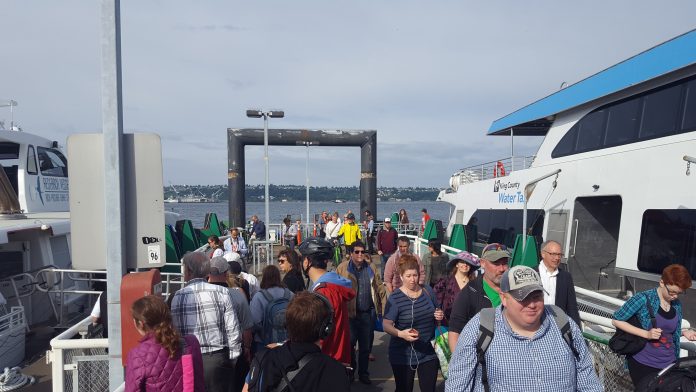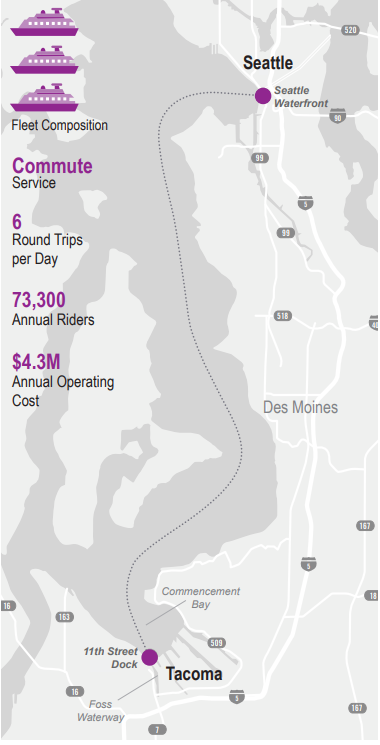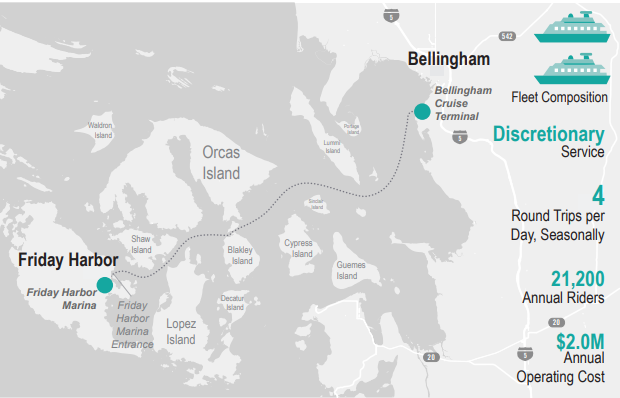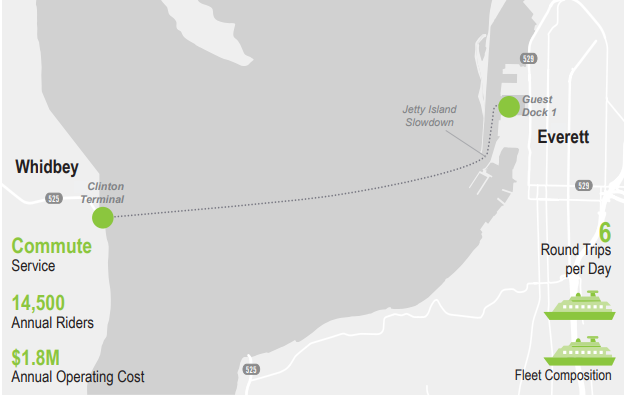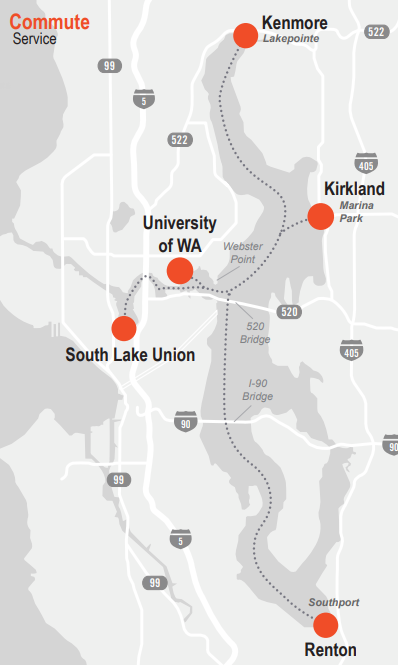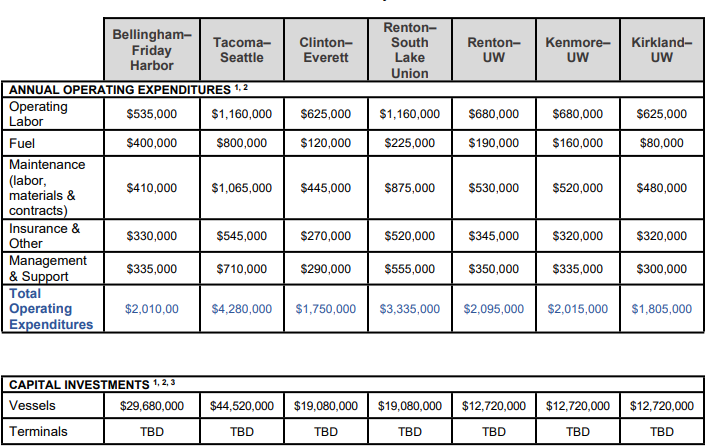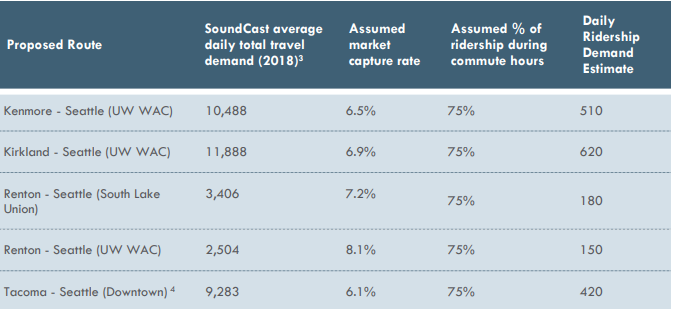The Puget Sound Regional Council (PSRC) has analyzed seven passenger-only ferry routes and issued results this month. Two Lake Washington routes–Kirkland to the University of Washington (UW) and Kenmore to UW–rose to the top, showing significant time savings and ridership potential with relatively low operating cost expected. Commissioned by the Washington State Legislature in 2019, the report evaluates demand and costs for new Puget Sound passenger ferry routes. The Legislature authorized PSRC to lead the study due to the agency’s experience with a 2008 passenger-only ferry study, whose identified near-term routes will all be in operation by the end of 2020.
Passenger ferries in the region can be traced back to Native American water transportation and the Mosquito Fleet that operated steam-powered small craft in the late 1800s and early 1900s. Passenger services were converted to vehicle ferries in the Great Depression era and as car infrastructure ramped up. Passenger-only service was reintroduced to the region in 1986 and today they operate in King and Kitsap counties, offering faster trips than more lumbering vehicle-laden ferries.
This round of research reviews the 12 county area–Clallam, Island, Jefferson, King, Kitsap, Mason, Pierce, San Juan, Skagit, Snohomish, Thurston, and Whatcom–surrounding Puget Sound, with a focus on evaluation of new routes, landing sites, potential demand, estimated capital and operating cost, and recommendations on electrification. The process for the planning and feasibility-level study has now gone through a four-step screening process to evaluate, rank, and whittle down a field of 45 routes down to 36, 18, and now seven.
Evaluating the Routes
When The Urbanist last reported on the study, PSRC had only screened the numbers of routes to just eight with the eighth route still to be decided between Suquamish to Seattle or South Whidbey to Everett. The agency has since selected the second option for the draft study, and eliminated Gig Harbor to Seattle from further analysis. The remaining routes were put through the latest set of analysis and assessment that include travel time savings, capital and operations costs estimation, and ridership demand analysis.
Routes analyzed in most depth are:
- Tacoma to Seattle
- Bellingham to Friday Harbor
- Whidbey to Everett
- and four Lake Washington/Lake Union Routes
- Kenmore to the University of Washington
- Kirkland to the University of Washington
- Renton to the University of Washington
- Renton to South Lake Union
Mock route profiles are developed for all seven of the PSRC’s chosen routes to generate figures for cost and ridership, and detect hurdles and opportunities. Outside of Bellingham-Friday Harbor, which is framed as a seasonal recreational route operating seven days a week with four roundtrip a day, all the routes are given a hypothetical commute-focused, year-round, and five days a week in operation with six departures a day service.
For PSRC’s hypothetical routes, financial analysis found annual operating cost ranging from two to four million dollars. Operating costs are a reflection of route length that causes higher operating, maintenance, and fuel costs. High capital costs for Bellingham-Friday Harbor and Tacoma-Seattle can be attributed to the need for a larger vessel for seaworthiness and passenger comfort. Routes like Tacoma-Seattle and Renton-South Lake Union also need an extra vessel due to the length of the routes, further increasing capital costs. Overall, initial investment costs for each route start in the $10 million range and can reach in to the high tens of millions, as terminal costs are given a Rough Order of Magnitude estimate of $5 million to $35 million if a replacement or new build is needed.
While not studied in depth enough to develop terminal costs, the agency does explore hypothetical landing sites for infrastructure and regulatory needs. Multimodal connections and local context are also inspected. For example, the UW stop that serves three of the routes in the study would need to have its existing dock by the Waterfront Activities Center be replaced to support services. A replacement would have to be compatible with existing uses, the crew team, and recreation boating. Proximity to the light rail and bus service seems like the main attraction of this potential terminal, accessibility improvements are noted as a need for those connections to be realized.
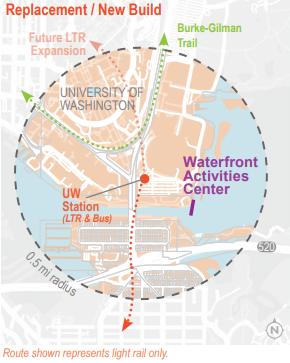
For ridership, numbers do not project induced demand, and only approximate existing ridership for the corridor and the share expected to be captured by a passenger ferry route. PSRC also expects ridership numbers to increase with development in the vicinity of potential terminals. This is important context for some of the less impressive routes for projected ridership. Especially given their capital and operating costs, Kenmore-UW and Kirkland-UW stand out as potentially capturing the most annual ridership at some of the lowest cost among the routes. Some crude math puts those two routes at $15 and $12 of theorized operating cost per passenger, respectively. The other routes range from $40 to $120 per passenger.
As you might expect, time savings are found with every route chosen to make it this far into the analysis. Compared to bus service, passenger ferry service for the Tacoma-Seattle route and the Lake Union/Lake Washington routes reduced travel times by more than 15 minutes, amounting to a 20% time saving for longer routes like Tacoma-Seattle and Renton-South Lake Union. For a shorter route like Kirkland-Seattle, it nearly cuts travel time by 50%. Non-central Puget Sound routes see much greater time savings, cutting travel times by about 60%.
Lastly, PSRC studied electrification for each route. Only the shorter routes, Whidbey-Everett, and Lake Union/Lake Washington routes are noted as candidates for electrification. Batteries are far less dense than liquid diesel fuel, so the longer routes would require much larger batteries that would be costly and heavy. There is discussion to lower speeds or reduce capacity to make a battery powered ferries more viable, but that damages the main appeals of a ferry service alternative.
Next steps and implementation
PSRC’s December report ends on implementation considerations and next steps. Due to 2006 legislative direction, passenger ferry implementation is to be left to local entities; the agency recommends that the first step toward implementation is incorporating route, associated facilities, and last- and first-mile connections into local and regional planning frameworks. For the examined King County only routes, the duty would likely go to King County Metro that operates ferry services with the water taxi. Routes that travel to Pierce, Island, Snohomish, San Juan, and Whatcom Counties will need to identify what agency to put in charge, be it a port, transit agency, or another body.
Even though the Legislature won’t implement the routes, the state can still support policy work and provide funding options of local jurisdiction to implement passenger ferries. Additional space for the state may also exist in conducting an analysis of cumulative impacts of ferry traffic on other marine traffic and uses and the environment.
The general purpose of the study is to provide information, so PSRC included a second step to develop a business and implementation plan to refine and develop more data for regional passenger ferry service. A full financial plan would be a part of that plan, which would develop a fare structure, identify and develop agreements for landing sites location, and build a realistic implementation schedule.
A final draft of the Puget Sound Passenger-Only Ferry Study is due to the Washington State Legislature in 2021. PSRC is continuing work on the study and you can follow their work on the study website and sign-up to receive updates. The agency is also open to feedback, which can be provided to POF_Study@psrc.org by December 28, 2020.
Shaun Kuo is a junior editor at The Urbanist and a recent graduate from the UW Tacoma Master of Arts in Community Planning. He is a urban planner at the Puget Sound Regional Council and a Seattle native that has lived in Wallingford, Northgate, and Lake Forest Park. He enjoys exploring the city by bus and foot.

